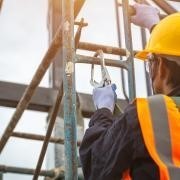In March 2022, falls from height sadly remain the number one cause of serious injuries and workplace deaths in Great Britain, especially within construction.
This might be considered surprising given that the risks around working at height are well-known, and the specific regulations that govern this activity and set out to reduce and prevent death and injuries (namely the Work at Height Regulations 2005) have been in place for well over 15-years. A fall from only a short distance can have serious, long-lasting and even life-changing consequences. There is also readily accessible guidance in the form of INDG 401 which provides a short guide, to help Employers know what they need to be doing.
However, recently there has been a flurry of criminal prosecutions in the North West which serve to highlight and remind some duty holders that more needs to be done to ensure continued compliance in this area. Some employers may argue that ‘real’ responsibility for ensuring policies, procedures and arrangements for work at height are met, instead sit with individuals who are actually carrying out the work.
In health and safety law, corporate and individuals combined both owe consecutive and overlapping legal duties under the Health and Safety at Work etc. Act 1974 (“HSWA”) to positively ensure the health, safety and welfare of employees and non-employees, so far as is reasonably practicable. As such, legal responsibility for work at height rests with employers and individuals, and both can attract criminal liability if work at height is not appropriately managed.
Organisational management arrangements are only effective if those who are expected to use them have:
Correctly identified the risks (suitable and sufficient risk assessment); Understood how to control them (planning); Ensured that all concerned with the activity know about the relevant risks, and the findings from any risk assessment (instruction, information and training); Made sure that implementation is carried out (communication is key); and Even if a company has effective policies and procedures, does it really know that those are being followed day-to-day? This comes back to the overall adequacy of an Employers’ arrangements for supervision, and regular monitoring or auditing (checking) that those arrangements are being followed.In January 2022, a construction firm and its director were both sentenced after carrying out unsafe work at height on a roof of a multi-storey building in Manchester. The workers themselves were spotted working up on the roof with no safety measures in place to prevent falls. In the case of Exquiste Solutions (Alsager) Limited – the Health and Safety Executive (“HSE”) found that these breaches were in place for well over a month, and as such working at height in this way presented a significant risk of death or serious injury (even though no actual harm was caused).
The company itself was found guilty of its duty to positively ensure the health, safety and welfare of its employees so far as is reasonably practicable and fined £42,500 (non-insurable) and prosecution costs, and the company director was also found guilty of a breach of section 37 of HSWA.
Section 37 is intended to ensure that directors and senior officers hold personal responsibility for health and safety, and if it can be shown that a company has fallen foul of its obligations because of the consent, connivance or neglect of any director or senior officer, then the director or senior officer can be prosecuted too in a personal capacity.
The maximum penalty for individuals can be up to two years imprisonment, community orders, unlimited fines and/or directors’ disqualification. In this case, the company director received a community order of 270-hours unpaid work and was ordered to pay costs.
March 2022 provided yet another example, as it was reported that H Cumberbirch & Sons Limited have been sentenced following an incident where two bricklayers fell from height during the construction of a parapet wall. This arose from an incident back in October 2019 (enforcement action for health and safety matters is not subject to limitation), where two employees suffered serious injuries when the makeshift platform, they were working on collapsed. The two men, along with plywood boards and bricks, fell approximately eight feet to the concrete floor below. The first man sustained fractured ribs, severe bruising and a large wound to his leg, the second man sustained severe bruising to his knees.
The court on sentencing will have likely considered that the breach had resulted in a high likelihood of the risk of death, even though death didn’t arise on this occasion. It is often forgotten that health and safety cases are not prosecuted on the basis of actual harm in a given incident, but on the basis of risk likelihood. This means that it is possible for a prosecution to be brought absent any incident or injury at all – merely on the basis of a failure to manage risk.
The HSE found that the work carried out by H Cumberbirch & Sons Ltd had not been properly planned, and the risk assessment fell short of considering how the parapet wall would be constructed and how the risk of falling from height would be prevented. As a result, there was a lack of suitable measures in place for mitigating against the risk of falling. Supervision was also found to be inadequate.
The company pleaded guilty to a breach of Regulation 4 (1) of the Work at Height Regulations 2005 and were fined £36,000 (non-insurable) and ordered to pay the prosecution costs. This financial penalty will have been in addition any other charges issued by the HSE under their fees for intervention regime, and separate to any civil claim that the individuals may have brought. In an ever-hardening insurance market (both for public and employers’ liability cover) and where in many industries, tenders or procurement processes now require full disclosure of past accident histories or near misses, incidents such as these (but also those where even ‘no actual harm’ may be caused) can potentially have an enormous commercial and reputational impact on businesses, generally and on ability to win and source work.
Therefore, and in light of these recent cases, some key questions that Employer’s may want to ask are:
Does our senior leadership team, and culture help to ensure that our work actives are properly planned and managed? Do the Directors and Senior Officers know what is expected, in terms of legal responsibilities and what steps can be taken to discharge their obligations? Are we satisfied that our H&S arrangements are adequate, and if so, do we monitor and audit them regularly to ensure that they are being followed in practice? Is the level of information, instruction and training concerning working at height appropriate? Are those responsible for carrying out risk assessments suitably trained, so to know what to look at for and how to implement any necessary controls?Our Health and Safety Team have a variety of ways in which we can help support duty holders, clients and business achieve compliance with health and safety law. If you need any specialist advice or support in navigating these issues, please do not hesitate to contact a member of our Regulatory Team.
This article contains a general analysis and overview of information only. It does not constitute, and should not be relied upon, as legal advice. You should consult a suitably qualified lawyer on any specific legal problem or matter so that specific advice can be given.
Brabners in Lancashire is located at Sceptre Court, Walton Summit. If you would like to discuss anything raised in this article, please give us a ring on 01772 823921, quote “LBV” and a member of our team will be happy to assist you.
If you would like to receive more content like this, please head to our website where you can subscribe to receive regular updates of current articles and events.























